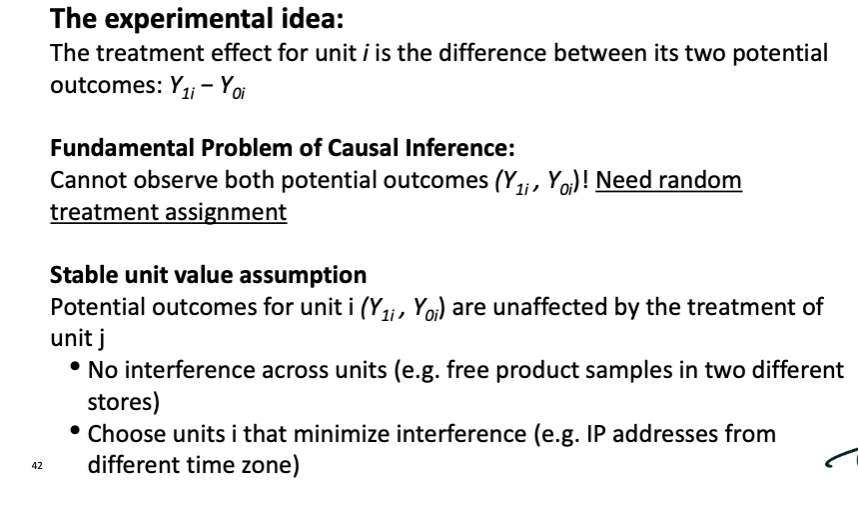Empirical Marketing - Week 5
1/26
There's no tags or description
Looks like no tags are added yet.
Name | Mastery | Learn | Test | Matching | Spaced |
|---|
No study sessions yet.
27 Terms
What is the definition of brands according to the American Marketing Association?
The American Marketing Association defines brands as a “name, term, design, symbol or any other feature that identifies one seller’s good or service as distinct from those of other sellers”.
What is brand equity? (recap)
- Brand equity is the set of assets and liabilities linked to a brand, its name, and its symbol, which add to or subtract from the value provided by the firm’s offering and relationships.
For a firm, brand equity equals the sum of all the customer lifetime value (CLV) associated with all future and existing customers than can be attributed to the firm’s brand.
- Brand equity “lies in the mind of the customer” which means that it is difficult for competitors to copy it, adding to the sustainability of brand-based barriers.
- This also makes it hard for firms to adapt or change their brand identity.
What is associative network memory model of brand equity?
A psychological model describes how brands work.
What is included in the associative network memory model of brand equity?
The key characteristics of a brand, which influence its brand equity, are brand awareness and brand image.
What is brand awareness and brand image?
- Brand awareness or familiarity is the customer’s ability to identify a brand.
- Brand image is customer’s perceptions and associations with the brand.
How does the associative network memory model of brand equity work?
- The associative network memory model argues that the human mind is a network of nodes (represent brand awareness) and connecting links (represent brand image).
- In the network memory model, brand strategy involves first building awareness to provide an anchor point, then building linkages to positive, unique memory nodes to establish an identity that matches target customer’s needs in a cost-efficient manner. The thickness of the line between 2 nodes represents the strength of the association between these 2 memories in a consumer’s mind.
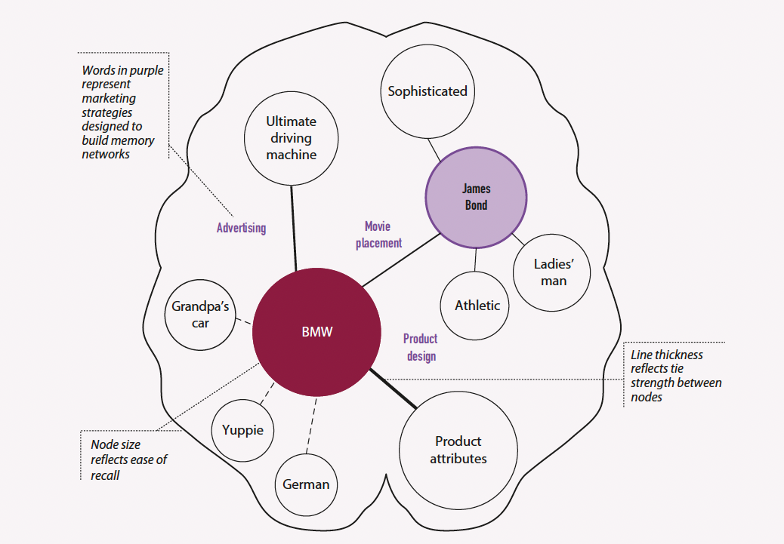
What are the elements designed to develop brand position?
Brand positioning reflects how and where the firm hopes to appear in customers’ mind. Design elements to develop a brand position include:
· Brand awareness
· Brand image
· Brand objectives
· Brand relative advantage
· Brand sustainability
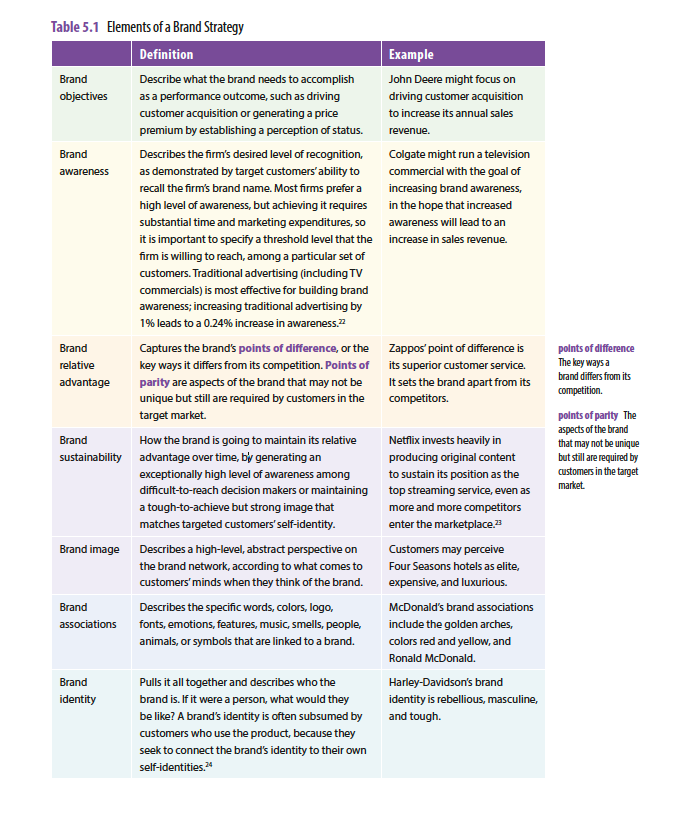
What are the three steps to building a brand equity?
- Building a high level of brand awareness among the firm’s targeted customers, which then provides an anchor point for linking the easily recallable brand name to the elements that define its meaning and image.
- Linking the brand name to the brand’s points of parity and difference, which helps define the brand’s relative advantage – this step defines how the brand will be positioned against its competition.
- Building a deep emotional connection or “relationship” between the brand and targeted customers – moving beyond functional differentiation implies a true, emotional connection which is the essence of building a powerful, long-lasting brand image.
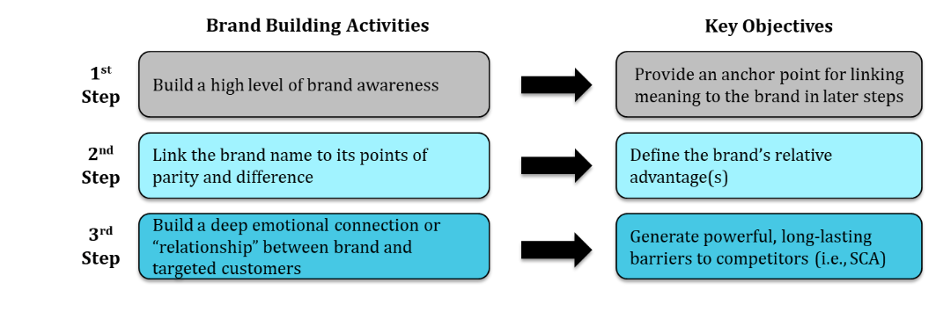
What are the benefits from brand equity?
- Sales growth: sales benefit from strong brands, because brands make it easier to acquire new customers, who perceive less risk, higher quality, and better performance of a brand with strong equity.
- Profit enhancement: the benefits that drive sales growth also can enhance a firm’s profitability by reducing costs or allowing the firm to charge higher prices for its product.
- Loyalty effects: a strong brand makes customers more loyal, which often provides the largest barrier to competitive entry.
What is the loyalty matrix?
- True loyalty: when both attitudinal and behavioral loyalty are high; positive feelings and actions.
- Spurious loyalty: customers buy but have ambivalent or negative feelings; at the first convenient opportunity they will switch.
- Latent loyalty: customers express positive attitudes but fail to actually buy a firm’s products. Often due to lack of local purchase access or prices beyond their means.

What is brand architecture?
- Brand architecture defines both the rationale and the structure among the firm, its products and its brand/product extension.

In brand architecture, what is house of brands?
- Can create distinctly positioned brands that convey the personality of a firm’s products by means of physical or perceptual benefits.
- Each brand has its own brand equity.
- A firm command more shelf space.
- Firm incurs higher costs of advertising and new product introductions.
In brand architecture, what is endorsed brands?
- Endorsed brands help differentiate and boost corporate brand.
- Faster market penetration.
- Quality assurance.
- Can be subject to negative spillover effect of brand image in case of scandal.
- Brand dilution
In brand architecture, what is sub - brands?
- High visibility parent brand
- Vulnerability
- The stronger is the link between the master brand and sub brand the stronger will be the positive and negative spillover
High operating expenses of managing multiple brands
In brand architecture, what is branded house?
- Economies of scale in marketing and efficiency in creating brand equity.
- Lower per item promotion cost.
- Consumers are likely to transfer loyalty from one brand to another.
- Efficient means to communicate with public, government and stakeholders.
- Helps brand extensions.
- Limited ability to expand in unknown product categories due to loss of brand identity.
What is brand extensions?
- Launch of new offerings by leveraging an existing brand, whether through line or category extensions.
What is brand line extensions?
- With brand line extensions, the new offering is in the same product category but targets a different segment of customers, usually with a slightly different set of attributes.
What is brand category extensions?
- With brand category extensions, the new offering instead moves to a completely different product category.
Are all brand extensions succeed?
- Not all brand extensions succeed: many examples of unsuccessful brand extensions. There must be perceived fit between the parent brand’s image and the extension on a dimension that is relevant to the customer.
- Brand extensions can be stretched farther if done incrementally. Higher quality brands generally can be extended further.
- Example: Oreos sandwich cookie is familiar with customers with the filling between 2 cookies. They extend this product by making ice cream cake or ice cream with the same characteristics —> success extension. However, McPizza is not a success because McDonald’s reputation for pizza is not recognized, compared to their rivals like Domino Pizza —> unsuccess extension.
What is vertical extension?
The planned process where a firm changes an offering’s price and performance positioning over time (moving up or down market):
· Moving up market: the extensions need to be realistic, so customers recognize and accept the brand fit. And the product should be differentiated in some way.
· Moving down market: firm needs to elevate and differentiate the parent brand to decrease any potential (negative) brand overlap and make the brand extension distinguishable.
For managing brand based SCA, what is integrated marketing communications?
- To execute the 3 brand building steps and effectively implement the firm’s brand strategy, a firm typically uses multiple marketing communication formats, each of which has different strengths and weaknesses that define when each will be most effective, as well as the optimal combination of different formats:
· Advertising: a way to persuade customers to act, think, or recognize in ways favorable for firms.
· Sales promotion: any action a firm takes to promote sales, usage or recognition of its products or services.
· Influencer marketing: relying on individuals who influence others’ behavior or thinking, can produce strong results but it is risky as well.
· Public relations: communication process that builds mutually beneficial relationships between organizations and their publics.
· Events and experimental marketing: positive experiences for customers through events that support face-to-face contacts.
· Direct and interactive marketing
· Word of mouth (WOM)
· Personal selling.
For managing brand based SCA, what are the research approaches to understanding and measuring brand equity?
- To track the effectiveness or returns on marketing expenditures that seek to build brand equity over time, as well as understand the state of the brand following changes in strategy or competitive disruptions in the marketplace, a firm needs to measure its brand equity.
- Different approaches, methods, and metrics for measuring a brand’s health are available, depending on the manager’s objectives:
· Qualitative analyses: can be used in the early stages of a brand audit, e.g., to discover the level of brand awareness or brand associations via in-depth interviews or focus groups.
==> less structured and features smaller samples, best used early in a research process.
· Quantitative analyses can be used to identify the causes or drivers of desired outcomes, e.g., the effect of marketing communications on brand equity.
==> more deductive, designed to test theories and ideas, requires larger sample sizes and best used later in the brand audit process.
For managing brand based SCA, what is measuring brand equity using social media?
- User generated content can create a narrative about how people perceive a product or a brand.
- Rich associative information contained in social tags can act as a proxy measure of customer-based brand equity.
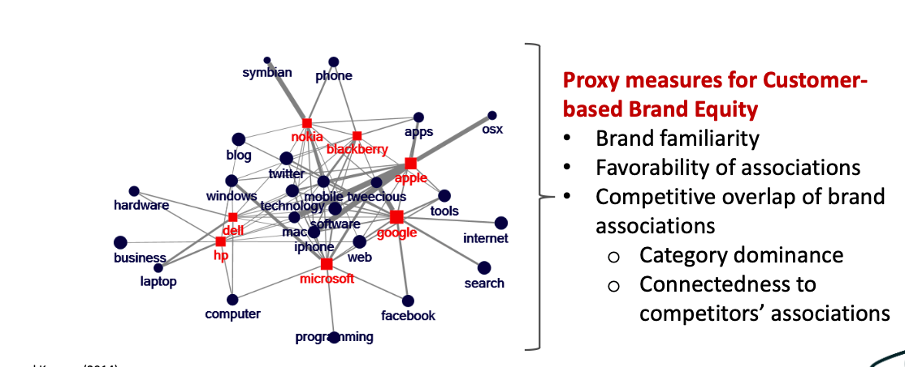
Describes this image.
· Red squares represent brands, blue circles represent associated terms or concepts customers link with those brands. The lines connect between brands and concepts show how closely customers associate that concept with that brand. The thicker the line, the stronger the association.
· Brand familiarity: how well-known a brand is, more connections can signal more familiarity.
· Favorability of associations: how positive or valuable the brand’s associations are (Apple is linked to iPhone)
· Competitive overlap of brand associations:
+ Category dominance: if many associations cluster around a brand, it may dominate that product category.
+ Connectedness to competitors’ associations: if a brand shares associations with others, it may be in a competitive or contested space.
For managing brand based SCA, what is measuring brand equity using survey?
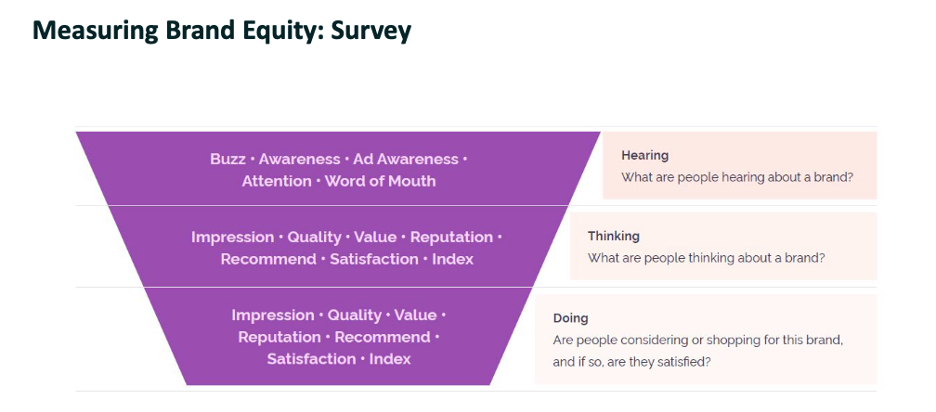
For managing brand based SCA, what is measuring brand equity using marketing experiments?
- One increasingly popular method is to rely on marketing experiments (A/B tests) or quasi-experimental design (natural experiments, difference-in-differences)
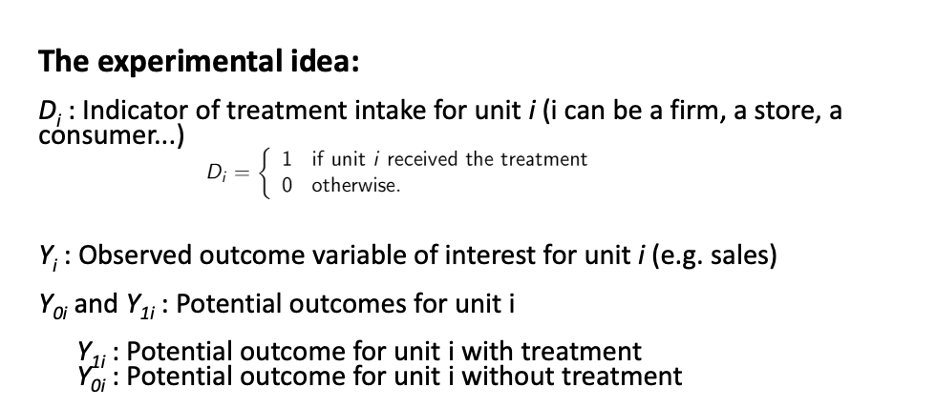
What is the fundamental problem of causal inference?
